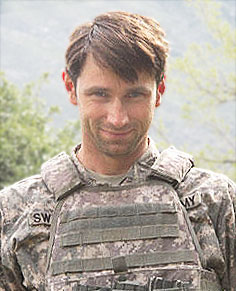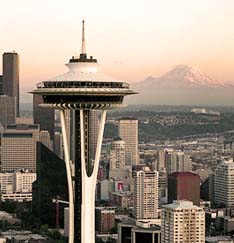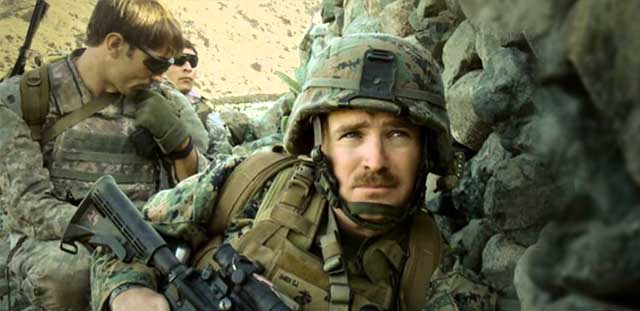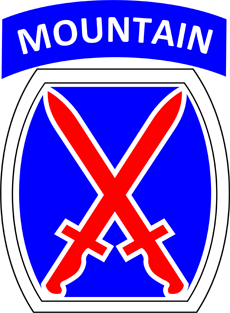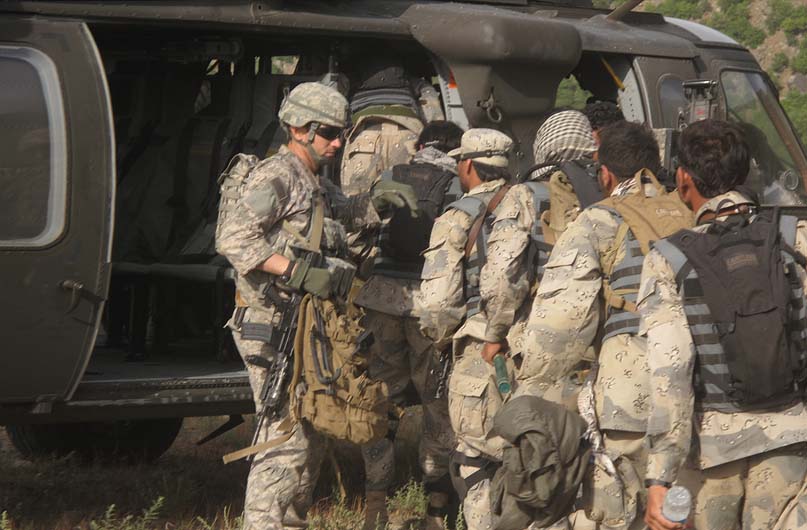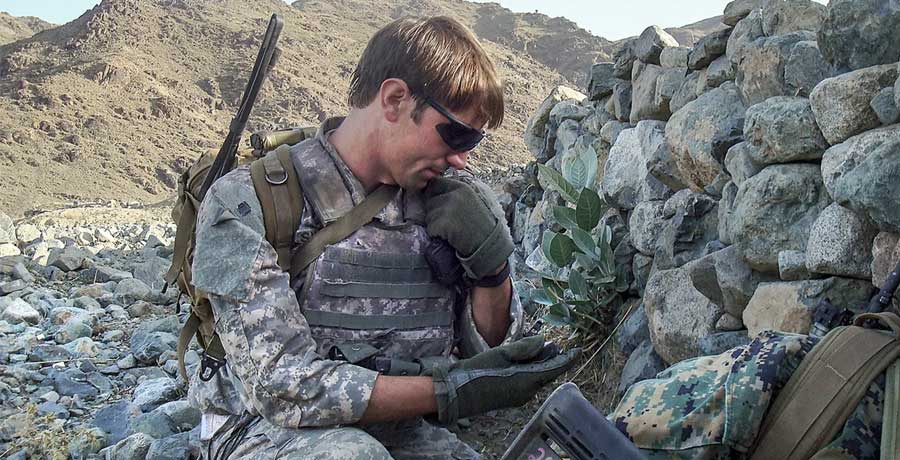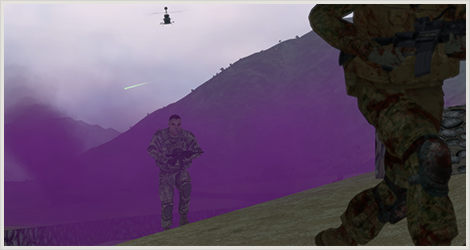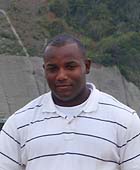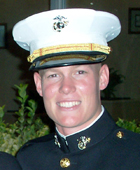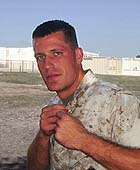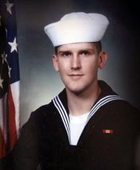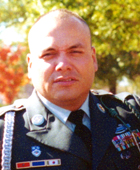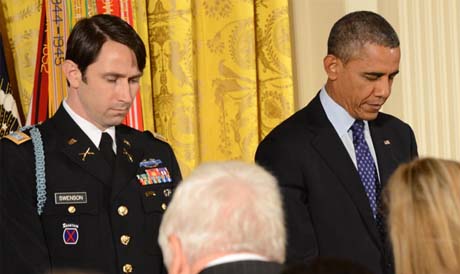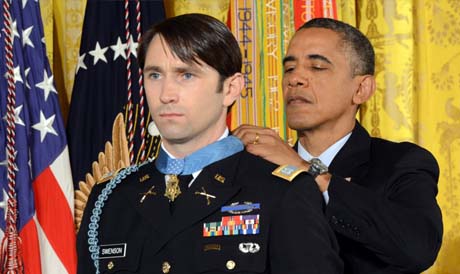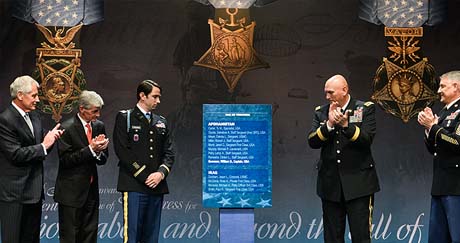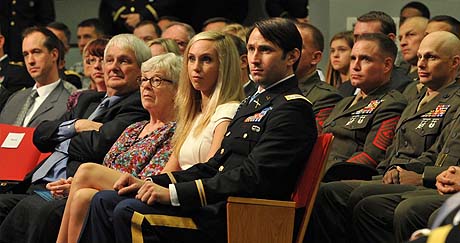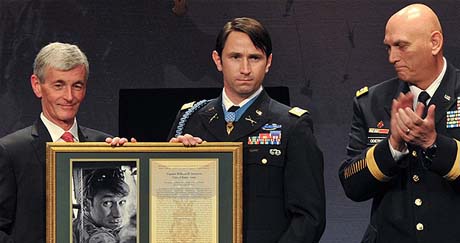Image above: Capt. William Swenson looks out at the rough terrain of Eastern Afghanistan from a Black Hawk helicopter. Photo courtesy of U.S. Army.
An hour into the firefight, communication with the lead elements had been lost and could not be re-established. Surrounded on three sides, and fixed by overlapping fields of fire with crew-served weapons, RPGs and sporadic enemy indirect fires, the TAC' s position was desperately untenable. Wounded troops accumulated, including Williams, who had been shot in the arm, and Garza, whose eardrums were ruptured by an RPG. Physically unable to evacuate the wounded down the steep terraces and unwilling to enter the enemy kill zone in the wash, Swenson coordinated for combat aviation and helicopter support.
The enemy, now within 50 meters, had successfully isolated Swenson from his partner advisor, Westbrook. Swenson learned that Westbrook was shot in the upper chest, and lay in an exposed position. Attempting to reach Westbrook, Swenson returned accurate fire on the enemy, despite coming under direct enemy fire that killed two adjacent ANA soldiers, and wounded another. Finally able to repel the enemy with the assistance of another ANA soldier, Swenson, Garza and Fabayo maneuvered over 50 meters of open space, fought their way to their fallen comrade, and began to render first aid.
Now consolidated, but still in the kill zone under a barrage of enemy fire, Fabayo observed three insurgents maneuvering out of a house to the front of the TAC. Fabayo made direct visual contact with an insurgent who was wearing fatigues, body armor and a helmet, waving for Fabayo to surrender. Calling to Swenson, Fabayo reported the insurgent' s presence and their demands to surrender to the Taliban. Outnumbered, flanked and facing enemy capture, Swenson put down his radio and halted his treatment of Westbrook long enough to reply to the enemy' s demands for surrender, by throwing a hand grenade. Following his example, the members of the TAC rallied. Swenson' s example, and his element' s stout resistance, effectively disrupted the enemy attack and pushed them back beyond hand grenade range.
At 7:47 a.m., after an hour and forty minutes of fighting, a team of OH-58D Scout Helicopters — call signs Palehorse 50 and Palehorse 60 — arrived in the valley. Swenson, still treating Westbrook, whose condition was quickly deteriorating, began to talk the aircraft' s fires on the various enemy targets he had observed around the valley. The enemy sporadically engaged the aircraft, yet appeared hesitant to engage coalition forces while they were overhead. This provided the TAC the slim opportunity they needed for successful retrograde back to the support-by-fire position A, or SBF-A. Swenson, Fabayo, and Jonathan Landay carried Westbrook, and with the group suffering more casualties every moment, the column ran, bounded, and broke contact down the steep terraces.
After what seemed like hours under effective and suppressive enemy fire, the combined force arrived at SBF-A and began immediate medical evacuation, or MedEvac, procedures. Soon after, a UH-60 helicopter arrived at the landing zone, located outside of small arms and RPG fire, and Swenson loaded Westbrook who was immediately taken to the forward support hospital at FOB Wright. The valiant effort by Swenson and the members of the TAC to maneuver under accurate and unmitigated enemy fire, moving Westbrook as well as ambulatory and non-ambulatory Afghan casualties, no doubt saved the lives of Westbrook and several others. Unfortunately, Westbrook would later die of his wounds, but not before departing theater and spending the last few weeks of life with family and loved one.
After Westbrook' s evacuation, Swenson and Fabayo manned an ABP unarmored vehicle and reentered the kill zone at least twice, evacuating wounded and bringing them to the casualty collection point, or CCP. Throughout, Swenson communicated via radio with the air support pilot, attempting to determine the location of the missing ETTs. At the same time, Marine Staff Sgt. Juan Rodriguez-Chavez and Marine Cpl. Dakota Meyer were retrieving wounded in an up-armored Humvee.
Image captured from video depicting the battlefield actions of Cpt. Swenson on Sept. 8, 2009 near the village of Ganjgal in Kunar Province, Afghanistan. He directed MedEvac landing for the evacuation of his critically injured teammate, Sgt. 1st Class Kenneth Westbrook. The video was captured by two different MedEvac crew members and shows each crew member's perspective of events spanning the same time period. Video is courtesy of Mrs. Charlene Westbrook.
At around 8 a.m., contact was still not established with the three Marines and one Navy corpsman ETTs, and the unarmored truck carrying Fabayo and Swenson was too damaged to take back into the wash. A Combat Search and Rescue (CSAR) helicopter arrived on station, but it was clear that any landing zone in the immediate area would be dangerously close to enemy positions and RPG teams. The need for a ground recovery of all remaining casualties became clear. Going above and beyond the call of duty, Swenson began making preparations to return up the wash into the kill zone.
After convening with Fabayo, Rodriguez-Chavez, and Meyer at the CCP, Swenson returned with Rodriguez-Chavez and Fabayo to the ORP to gather all available combat power. Meyer remained at the CCP and evacuated injured teammates Williams and Garza. The convoy assembled by Swenson consisted of an up-armored Humvee, an armored ABP Humvee, and two up-Armored ANA vehicles. After picking up Meyer at the CCP, the convoy continued into the wash. The ANA vehicles stopped early in the movement to recover the first set of casualties encountered. Under withering fire and without the necessary combat power to sustain the rescue or the ability to extract themselves, Swenson pressed on. Swenson, Fabayo, Rodriguez-Chavez and Meyer took the up-armored Humvee all the way to the suspected objective area in the village.
While they succeeded in rescuing and recovering several ANSF wounded and dead, they were forced by the volume of fire to drive past several marked positions deeper into the ambush, because of the pinpoint accuracy of the enemy' s small arms fire. Throughout the trip, Swenson communicates with the air support pilot, calling in targets and inquiring about the location of the missing ETTs. After a dismounted search was unable to find the ETTs, the rescue party realized that previously isolated ANSF have been moving from the cover of their terraces to the wash in a desperate attempt for extraction, and were taking effective small arms fire, which produced three new casualties. Swenson made the decision to return to SBF-A, to download casualties, and assist the ANSF who had just come down off the terraces and into the wash.
At around noon, the CSAR aircraft finally spots the location of the missing ETTs, and attempts to land and recover the fallen. The rescue convoy provided covering fires from a westerly position as the CSAR bird tried to land, but is forced under close RPG fire to leave station. Swenson called for smoke to mark the location of the bodies, and then from the position at the entry of the town, the convoy began to maneuver the CSAR bird into a supporting position. ANA joined to support a rescue attempt of the fallen.
Swenson, Fabayo, Rodriguez-Chavez, Meyer, with another small contingent of ANSF following, moved back east to a closer position to the fallen. Their objective was now the smoke rising at the top of the hill that marked their fallen comrades. With Palehorse elements suppressing known and suspected insurgent strongholds, and Fabayo operating the M240 machine gun, they faced precise and deadly fire for a second time. Coming to a stop directly adjacent to the ETTs' position, they found their comrades in a deep trench that had been impossible to see from ground angles during previous trips into the valley. Meyer and Swenson, along with ANA and ABP soldiers, dismounted and loaded the bodies into the back of the flat-bed ANA Humvee, while Rodriguez-Chavez and Fabayo provided covering fire. Driving back down the wash, receiving accurate and sustained fire to their rear, they completed the recovery operation.
Capt. William Swenson leads Afghan Border Police members as they board a UH-60 Black Hawk helicopter, May 2009.
Swenson drove straight to the ORP to verify accountability of all soldiers with the ANSF. It would be determined after the engagement that Swenson' s actions directly contributed to the preservation of more than a dozen Afghan lives. Swenson was the core of the initial defense and two subsequent rescue efforts. In seven hours of continuous fighting, Swenson braved intense enemy fire, and willfully put his life in danger against the enemy' s main effort, multiple times in service of his fallen and wounded comrades, his unit, his country, and his endangered Afghan partners.
”The Battle of Ganjgal was ferocious. And it was tragic. And we lost so many good lives that day. But following the violence, and the death, came inspiration. And we were inspired by those who fought there, by those who would not accept defeat. ”
- John M. McHugh, Secretary of the Army
Hall of Heroes Induction, October 16, 2013

